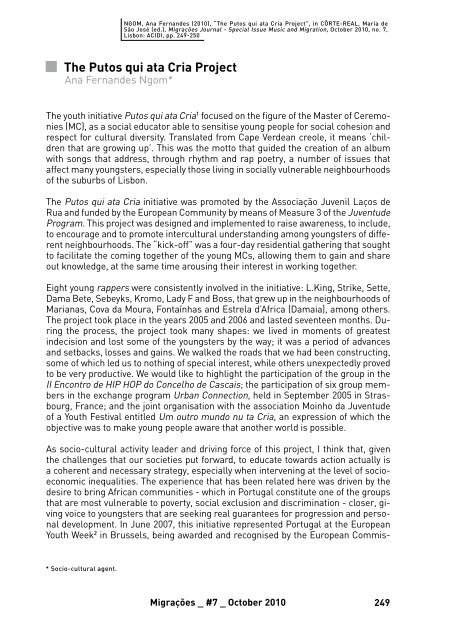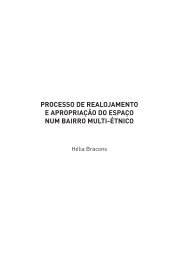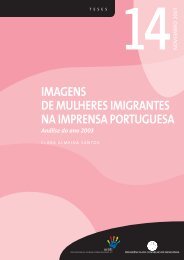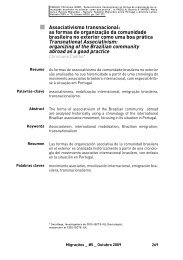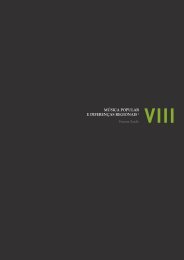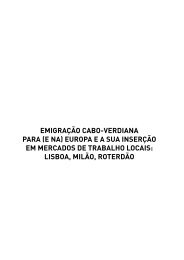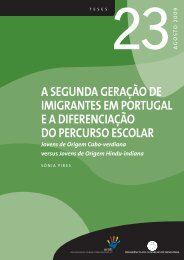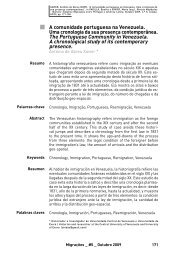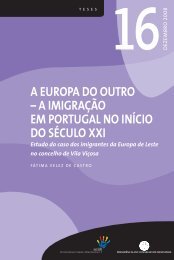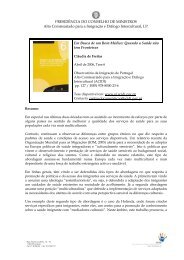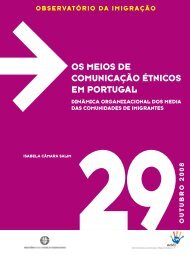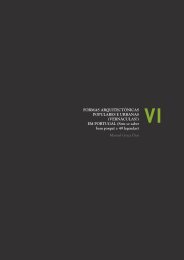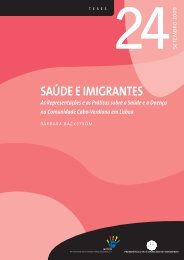The Putos qui ata Cria Project - Acidi
The Putos qui ata Cria Project - Acidi
The Putos qui ata Cria Project - Acidi
- No tags were found...
You also want an ePaper? Increase the reach of your titles
YUMPU automatically turns print PDFs into web optimized ePapers that Google loves.
NGOM, Ana Fernandes (2010), “<strong>The</strong> <strong>Putos</strong> <strong>qui</strong> <strong>ata</strong> <strong>Cria</strong> <strong>Project</strong>”, in CÔRTE-REAL, Maria deSão José (ed.), Migrações Journal - Special Issue Music and Migration, October 2010, no. 7,Lisbon: ACIDI, pp. 249-250<strong>The</strong> <strong>Putos</strong> <strong>qui</strong> <strong>ata</strong> <strong>Cria</strong> <strong>Project</strong>Ana Fernandes Ngom*<strong>The</strong> youth initiative <strong>Putos</strong> <strong>qui</strong> <strong>ata</strong> <strong>Cria</strong> 1 focused on the figure of the Master of Ceremonies(MC), as a social educator able to sensitise young people for social cohesion andrespect for cultural diversity. Translated from Cape Verdean creole, it means ‘childrenthat are growing up’. This was the motto that guided the creation of an albumwith songs that address, through rhythm and rap poetry, a number of issues th<strong>ata</strong>ffect many youngsters, especially those living in socially vulnerable neighbourhoodsof the suburbs of Lisbon.<strong>The</strong> <strong>Putos</strong> <strong>qui</strong> <strong>ata</strong> <strong>Cria</strong> initiative was promoted by the Associação Juvenil Laços deRua and funded by the European Community by means of Measure 3 of the JuventudeProgram. This project was designed and implemented to raise awareness, to include,to encourage and to promote intercultural understanding among youngsters of differentneighbourhoods. <strong>The</strong> “kick-off” was a four-day residential gathering that soughtto facilitate the coming together of the young MCs, allowing them to gain and shareout knowledge, at the same time arousing their interest in working together.Eight young rappers were consistently involved in the initiative: L.King, Strike, Sette,Dama Bete, Sebeyks, Kromo, Lady F and Boss, that grew up in the neighbourhoods ofMarianas, Cova da Moura, Fontaínhas and Estrela d’Africa (Damaia), among others.<strong>The</strong> project took place in the years 2005 and 2006 and lasted seventeen months. Duringthe process, the project took many shapes: we lived in moments of greatestindecision and lost some of the youngsters by the way; it was a period of advancesand setbacks, losses and gains. We walked the roads that we had been constructing,some of which led us to nothing of special interest, while others unexpectedly provedto be very productive. We would like to highlight the participation of the group in theII Encontro de HIP HOP do Concelho de Cascais; the participation of six group membersin the exchange program Urban Connection, held in September 2005 in Strasbourg,France; and the joint organisation with the association Moinho da Juventudeof a Youth Festival entitled Um outro mundo nu ta <strong>Cria</strong>, an expression of which theobjective was to make young people aware that another world is possible.As socio-cultural activity leader and driving force of this project, I think that, giventhe challenges that our societies put forward, to educate towards action actually isa coherent and necessary strategy, especially when intervening at the level of socioeconomicinequalities. <strong>The</strong> experience that has been related here was driven by thedesire to bring African communities - which in Portugal constitute one of the groupsthat are most vulnerable to poverty, social exclusion and discrimination - closer, givingvoice to youngsters that are seeking real guarantees for progression and personaldevelopment. In June 2007, this initiative represented Portugal at the EuropeanYouth Week 2 in Brussels, being awarded and recognised by the European Commis-* Socio-cultural agent.Migrações _ #7 _ October 2010249
sion for Education, Training, Culture and Youth as a valuable practice that contributesto the participation and inclusion of youngsters with less opportunities.Notes1Available at http://www.myspace.com/putos<strong>qui</strong><strong>ata</strong>cria; http://www.youtube.com/watch?v=UL5aHxCoFCc;http://blogs.myspace.com/index.cfm?fuseaction=blog.view&friendId=93622327&blogId=359675328, accessed on23.06.2010.2Available at http://ec.europa.eu/youth/sharing-experience/doc/thematic_compendia/good_practices_inclusion.pdf (p.16), accessed on 23.06.2010.250 Music and Migration


